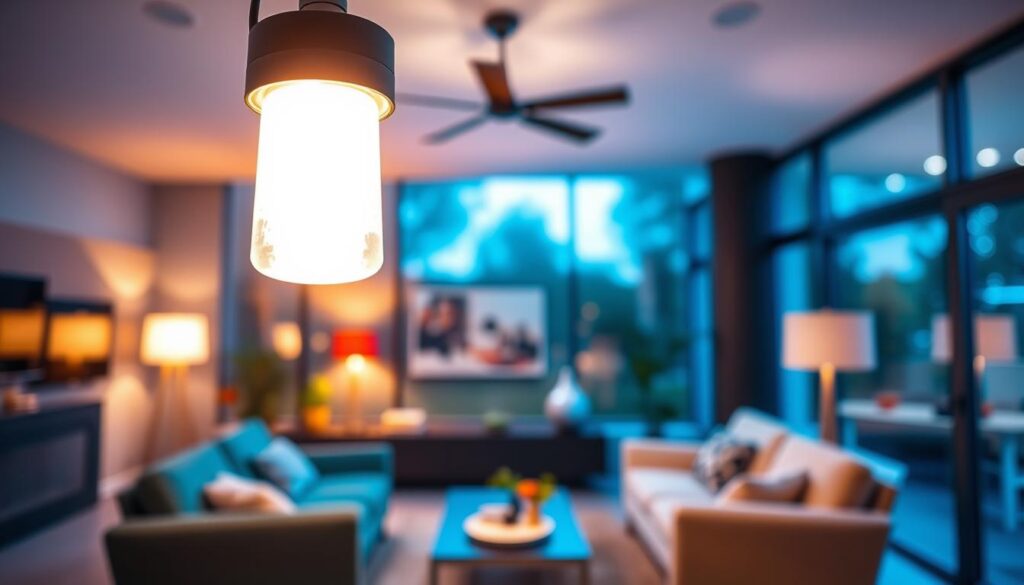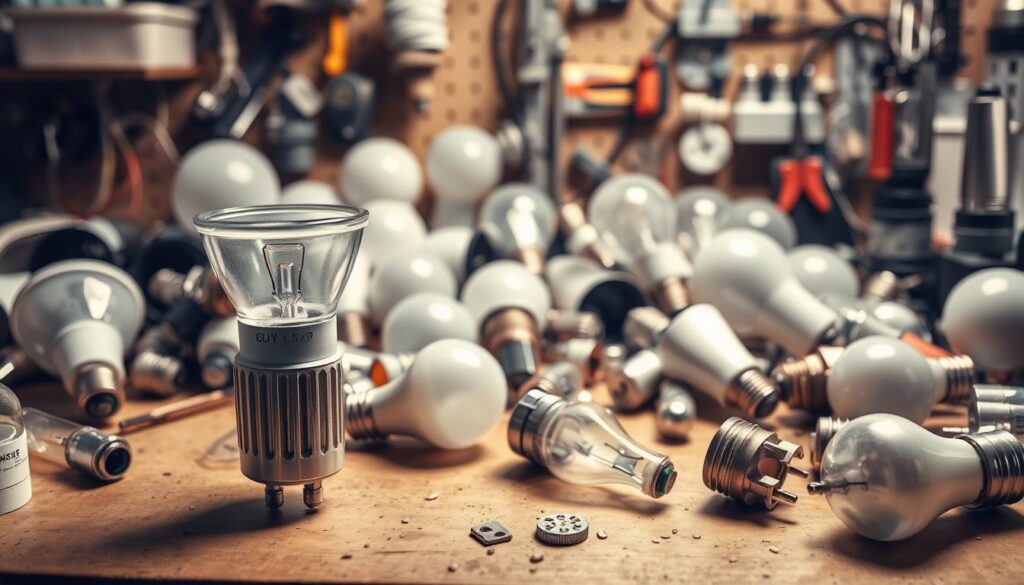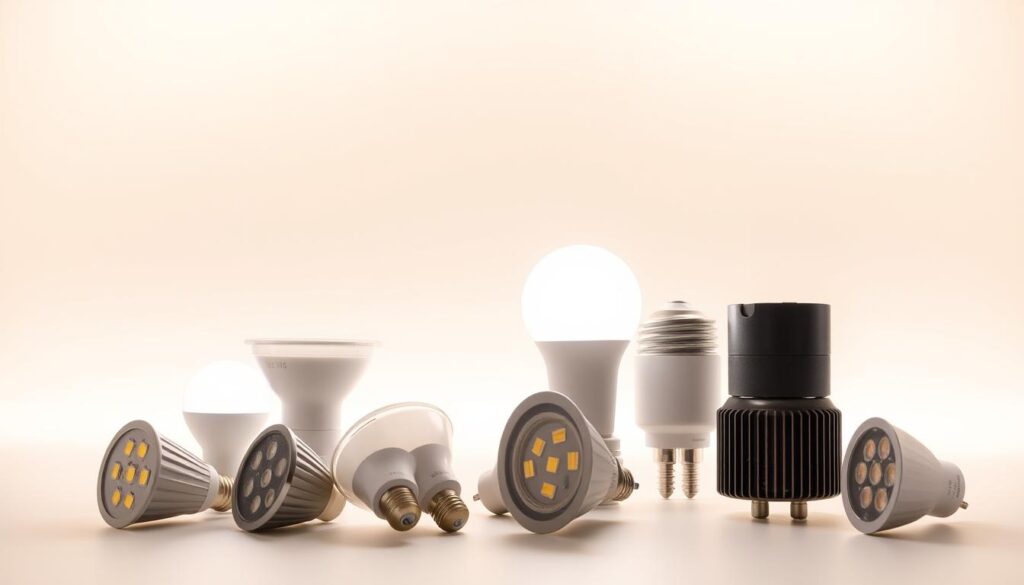Since September 1, 2018, the manufacture of halogen bulbs has been banned in the European Union, making LED lighting a more viable and necessary option.
As you consider upgrading your lamps and bulbs, you may be wondering what this means for your home and wallet. This comprehensive guide will walk you through the process of transitioning from traditional halogen GU10 bulbs to energy-efficient LED alternatives.
By making the switch, you’ll not only be complying with the latest regulations but also benefiting from the improved efficiency and longevity of LED lighting.
Key Takeaways
- Understand the benefits of transitioning from halogen to LED lighting.
- Learn about the technical differences between halogen and LED bulbs.
- Discover the various options available for replacing halogen GU10 bulbs.
- Address common concerns about compatibility, brightness, and quality of light.
- Gain the confidence to upgrade your lighting system to energy-efficient LED technology.
Understanding the Halogen to LED Transition
As the world shifts towards more energy-efficient lighting solutions, understanding the transition from halogen to LED technology becomes increasingly important. You are likely familiar with halogen bulbs, which were once considered a good alternative to incandescent lamps due to their improved energy efficiency and longer lifespan.
What Are GU10 Bulbs and LED Converters?
GU10 bulbs are a type of directional spotlight that has been widely used with halogen technology. They feature a twist-and-lock base design. LED converters, on the other hand, are devices that adjust electrical current to make it compatible with LED technology, ensuring the proper functioning and longevity of LED bulbs in systems originally designed for halogen lighting.
Why the EU Banned Halogen Bulbs
The European Union banned halogen bulbs as part of its initiative to improve energy efficiency. Halogen technology, while an improvement over traditional incandescent bulbs, still converts a significant amount of energy into heat rather than light, making it inefficient by modern standards. The transition to LED represents a significant technological advancement in lighting.
| Lighting Technology | Energy Efficiency | Lifespan |
|---|---|---|
| Halogen | Moderate | Up to 2,000 hours |
| LED | High | Up to 50,000 hours |
Benefits of Swapping Halogen GU10 for LED
Upgrading your lighting to LED technology can significantly impact your energy consumption and overall costs. By switching from halogen GU10 bulbs to LED GU10 spotlights, you can enjoy several benefits.
Energy Efficiency and Cost Savings
LED lighting technology offers dramatic energy efficiency improvements, using up to 90% less electricity than equivalent halogen bulbs. This significant reduction in energy consumption translates directly to lower electricity bills.
| Lighting Type | Energy Consumption | Lifespan |
|---|---|---|
| Halogen | High | 2,000-4,000 hours |
| LED | Low | 15,000-25,000 hours |
Longer Lifespan and Durability
LED bulbs typically last 15,000-25,000 hours compared to just 2,000-4,000 hours for halogen bulbs, meaning less frequent replacements and lower maintenance costs over time. The durability of LED technology makes these bulbs resistant to shock, vibration, and frequent switching.
Environmental Benefits
The environmental benefits of switching to LED lighting extend beyond energy savings to include reduced carbon emissions and less waste generation due to longer product lifespans. LEDs are also free from toxic materials like mercury.

Comparing Halogen and LED Specifications
The transition from halogen to LED lighting involves more than just replacing bulbs; it requires understanding their technical specifications. When comparing halogen and LED bulbs, it’s essential to look beyond wattage and consider lumens, colour temperature, and other factors that affect their performance.
Wattage Equivalents and Brightness (Lumens)
Wattage is no longer a reliable indicator of brightness, especially with the shift to energy-efficient LED technology. Instead, lumens are used to measure the actual light output. For example, a 50W halogen bulb produces around 600 lumens, which can be matched by a 6-8W LED. The wattage equivalence table shows that a 3W LED can replace a 30W halogen, 4-6W LED for 40W halogen, 6-8W LED for 60W halogen, 8W LED for 75W halogen, and 12W LED for 100W halogen.
| Halogen Wattage | LED Wattage | Lumens |
|---|---|---|
| 30W | 3W | approx. 300-400 |
| 40W | 4-6W | approx. 400-500 |
| 60W | 6-8W | approx. 600-700 |
Colour Temperature Options
Colour temperature, measured in Kelvin (K), determines whether the light appears warm (yellowish) or cool (bluish white). Halogen bulbs typically produce warm light below 3,300K. In contrast, LED lamps are available in a wide range of colour temperatures, from warm white (5,300 K). This flexibility allows you to customise your lighting environment for different purposes, such as warmer tones for relaxing spaces and cooler tones for task-oriented areas.
Assessing Your Current Lighting Setup
Assessing your current lighting setup is a vital step in swapping halogen GU10 for LED converters. To make an informed decision, you need to understand your existing lighting configuration.
Identifying Your Halogen Bulb Type
Before purchasing LED replacements, identify the type of halogen bulbs currently installed. Common types include GU10 (mains voltage) and MR16 (typically low voltage) with different base designs. Check your bulbs for markings indicating voltage, wattage, and base type.
Checking for Transformers and Dimmers
Examine your setup for transformers, often used in low-voltage halogen systems. These may need to be bypassed or replaced when switching to LED. Also, check if your lighting system includes dimmer switches and note their compatibility, as not all LED bulbs work with traditional halogen dimmers.
Determining Voltage Requirements
Determining the voltage requirements is crucial. Most residential GU10 halogens operate at mains voltage (220-240V in the UK), while MR16 halogens typically require a 12V transformer. Take account of the physical space available in your light fittings, as some LED replacements might be larger or shaped differently.
| Bulb Type | Voltage | Base Type |
|---|---|---|
| GU10 | Mains Voltage (220-240V) | Twist-lock base with two pins 10mm apart |
| MR16 | Low Voltage (12V) | Different base designs, often with a GU5.3 base |
For more information on LED bulbs, you can visit our guide on G9 LED bulbs.
Step-by-Step Guide to Swap Halogen GU10 for LED Converter
Replacing halogen GU10 bulbs with LED alternatives involves a few simple steps, but it’s crucial to consider your current lighting setup. Changing your old halogen bulbs for LED is very easy and can be done in two primary ways.
Direct Bulb Replacement (12V Systems)
For 12V systems, you can directly replace halogen bulbs with LED bulbs that operate at 12V DC. When selecting LED replacements, ensure they are compatible with your existing electronic transformers to minimise potential flickering issues. The process involves simply removing the existing halogen bulb by twisting it counter-clockwise and inserting the new LED bulb in the same manner.
Removing Transformers (Converting to 220V)
Alternatively, you can remove the transformer and install bulbs that operate at 220V AC. This involves disconnecting the existing transformer, bypassing it by connecting the mains wiring directly to new fittings, and installing mains-voltage LED bulbs. This approach eliminates energy wastage and potential compatibility issues associated with transformers.
Installation Safety Tips
When replacing bulbs, ensure the power is completely switched off at the circuit breaker before beginning any work. Use insulated tools, test wires with a voltage tester before touching them, and never overload circuits. Additionally, allow halogen bulbs to cool completely before attempting to remove them, as they can reach high temperatures.
Solving Common Compatibility Issues
When switching from halogen GU10 to LED converters, compatibility issues can arise, particularly with dimmer switches. Halogen lamps were universally dimmable, but LED lamps require special consideration to ensure they work correctly with dimmer switches.
Dealing with Dimmer Switches
Traditional dimmer switches designed for halogen lights often rely on higher minimum loads than LED bulbs provide, leading to compatibility issues such as flickering, buzzing, or failure to dim properly. To resolve these issues, you can either replace your existing dimmer with an LED-compatible version (trailing edge dimmers work best) or choose dimmable LED bulbs specifically tested and rated for use with legacy dimming systems.
| Issue | Cause | Solution |
|---|---|---|
| Flickering | Incompatible transformers or poor quality LED bulbs | Systematically test each component to identify the source |
| Buzzing | Electrical incompatibility between LED driver and power supply or dimmer switch | Replace either the LED driver or the dimmer switch |
| Inconsistent Dimming | Mixed brand or model of LED bulbs in multi-bulb fixtures | Use the same brand and model of LED bulbs |
Addressing Buzzing and Flickering Problems
For multi-bulb fixtures controlled by a single dimmer, ensure all bulbs are the same brand and model to prevent inconsistent dimming behaviour. In floor lamps and other portable fixtures with integrated dimmers, it’s crucial to use dimmable LED bulbs designed for compatibility with the type of dimmer mechanism in the lamp.

By understanding these compatibility issues and implementing the appropriate solutions, you can enjoy a seamless transition to LED lighting.
Conclusion: Making the Most of Your LED Upgrade
By transitioning from halogen GU10 to LED converters, you’re investing in a more sustainable and cost-effective lighting solution. This upgrade not only reduces your energy consumption but also enhances your overall lighting design and experience. To maximise the benefits, consider a holistic approach to reassess the placement, brightness, and purpose of each light in your space. Quality LED lighting from reputable brands ensures better colour rendering and longer lifespans. Additionally, eliminating transformers can rid you of annoying buzzing, making your lighting experience more enjoyable. With LED lights, you can enjoy efficient, environmentally friendly, and noise-free lighting.



